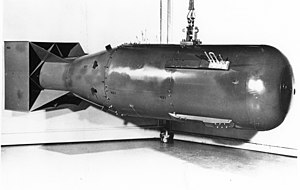Hiroshima atom bomb
| Little Boy | |
|---|---|
|
A post-war Little Boy model
|
|
| Type | Nuclear weapon |
| Place of origin | United States |
| Production history | |
| Designer | Los Alamos Laboratory |
| Produced | 1945 |
| Number built | 36 |
| Specifications | |
| Weight | 9,700 pounds (4,400 kg) |
| Length | 10 feet (3.0 m) |
| Diameter | 28 inches (71 cm) |
|
|
|
| Filling | Uranium-235 |
| Filling weight | 140 lb (64 kg) |
| Blast yield | 15 kilotons of TNT (63 TJ; 0.7 g mass equivalent) |
"Little Boy" was the codename for the atomic bomb dropped on the Japanese city of Hiroshima on 6 August 1945 during World War II by the Boeing B-29 Superfortress Enola Gay, piloted by Colonel Paul W. Tibbets, Jr., commander of the 509th Composite Group of the United States Army Air Forces. It was the first atomic bomb to be used in warfare. The Hiroshima bombing was the second artificial nuclear explosion in history, after the Trinity test, and the first uranium-based detonation. It exploded with an energy of approximately 15 kilotons of TNT (63 TJ). The bomb caused significant destruction to the city of Hiroshima.
Little Boy was developed by Lieutenant Commander Francis Birch's group of Captain William S. Parsons's Ordnance (O) Division at the Manhattan Project's Los Alamos Laboratory during World War II. Parsons flew on the Hiroshima mission as weaponeer. The Little Boy was a development of the unsuccessful Thin Man nuclear bomb. Like Thin Man, it was a gun-type fission weapon, but derived its explosive power from the nuclear fission of uranium-235. This was accomplished by shooting a hollow cylinder of enriched uranium (the "bullet") onto a solid cylinder of the same material (the "target") by means of a charge of nitrocellulose propellant powder. It contained 64 kg (141 lb) of enriched uranium, of which less than a kilogram underwent nuclear fission. Its components were fabricated at three different plants so that no one would have a copy of the complete design.
...
Wikipedia

